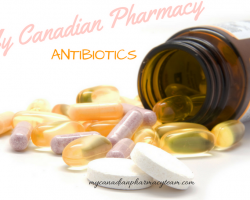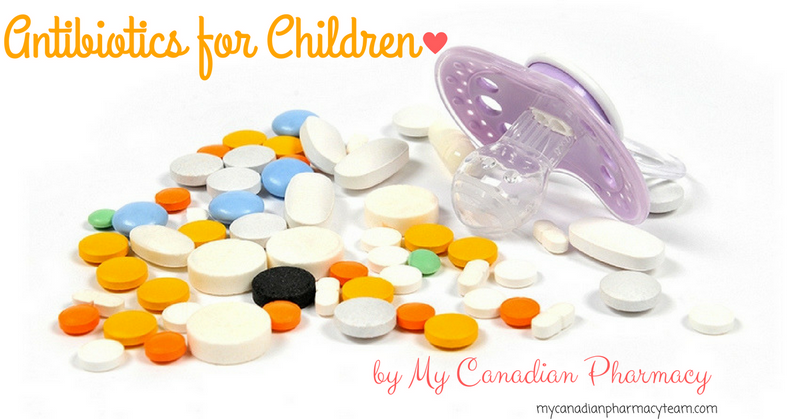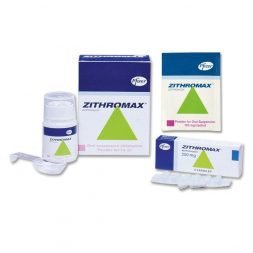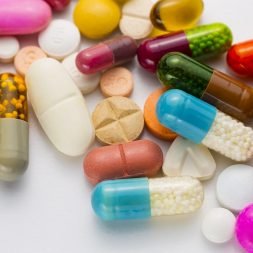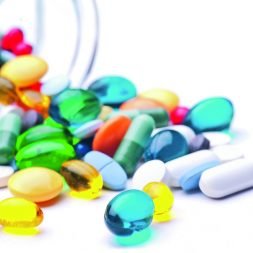Antibiotics are drugs that can inhibit microorganisms growth or destroy them. They include substances of plant, animal or microbial origin. Currently, this antibiotics definition is somewhat out of date, because there is a huge number of synthetic drugs created, but prototypes for their creation were natural antibiotics.
History of antimicrobials begins in 1928 when A. Fleming first discovered penicillin. This substance was really discovered, not created since it has always existed in nature. In wildlife it is produced by microscopic fungi of Penicillium genus, thus protecting themselves from other microorganisms.
In less than 100 years more than a hundred different antimicrobial drugs were created. Some of them are now obsolete and not used in treatment, and some are only introduced into clinical practice.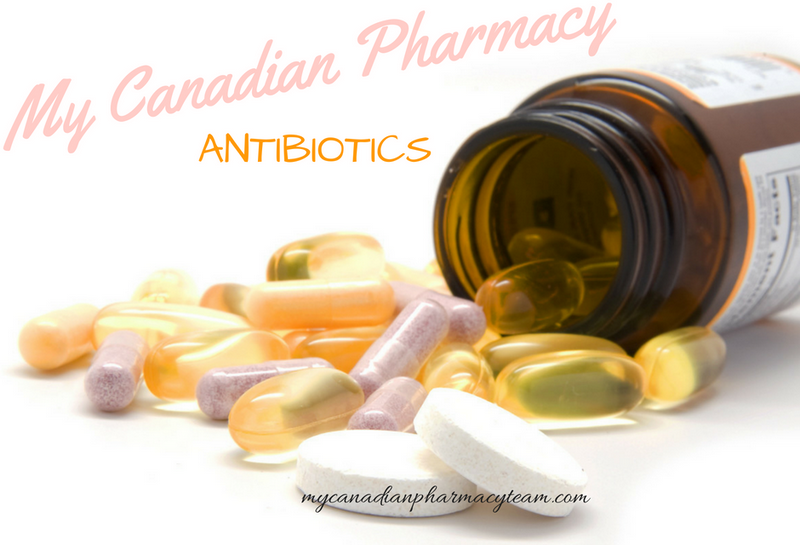
How do antibiotics work?
All antimicrobials according to the effect of exposure to microorganisms can be divided into two major groups:
- bactericidal – directly cause bacteria death;
- bacteriostatic – prevent microorganisms reproduction. Not able to grow and multiply, bacteria are destroyed by patient’s immune system.
These drugs implement their effects in many ways: some of these bacteria inhibit nucleic acids synthesis; others – inhibit bacterial cell wall synthesis; third – violate protein synthesis, and fourth – block respiratory enzymes function.
Groups of antibiotics
Despite the diversity of this group of drugs, all of them can be attributed to several main types. This classification is based on their chemical structure – drugs from one group have a similar chemical formula, differing from each other by presence or absence of certain fragments of molecules.
Today, there is the following classification of antibiotics:
- Penicillin derivatives. This includes all products created on the basis of the first antibiotic. In this group there are the following sub-groups or generations of penicillin preparations:
- natural benzylpenicillin, which is synthesized by fungi, and semi-synthetic drugs: methicillin, nafcillin;
- synthetic drugs: carbenicillin and ticarcillin, which have a wide range of effects;
- mecillam and azlocillin, having an even broader spectrum of action.
- Cephalosporins – next of kin of penicillins. The first antibiotic in this group was cefazolin C, produced by fungi of Cephalosporium genus. Drugs in this group mostly have a bactericidal effect, i.e. kill microorganisms. There are several generations of cephalosporins:
- I generation: cefazoline, cefalexin, cephradine and others;
- II generation: cefsulodin, cefamandole, cefuroxime;
- III generation: cefotaxime, ceftazidime, cefodizime;
- IV generation: cefpirome;
- V generation: ceftolozane, ceftobiprole.
Differences between various groups consist mostly in their efficiency – later generations have a greater spectrum of action and are more effective. Cephalosporins of I and II generations in clinical practice are now rarely used, most of them are not even produced.
- Macrolides – drugs with complex chemical structure, having a bacteriostatic effect on a wide range of microbes. Representatives: azithromycin, rapamycin, josamycin, leukomycin and others. Macrolides are considered one of the safest anti-microbial drugs – they can be used even by pregnant women. Azalides and ketolides – macrolides varieties with differences in the structure of active molecules.Another advantage of this group – they are able to penetrate into cells of human body, which makes them effective in treating intracellular infections: chlamydia, mycoplasma.
- Aminoglycosides. Representatives: gentamicin, amikacin, kanamycin. Effective against a large number of aerobic gram-negative microorganisms. These drugs are considered the most toxic, can cause quite serious complications. They are used to treat urinary tract infections, furunculosis.
- Tetracyclines. Basically, these are semisynthetic and synthetic drugs, which include: tetracycline, doxycycline, minocycline. Effective against many bacteria. The disadvantage of these drugs is a cross-resistance, that is, micro-organisms, which became resistant to one drug will be insensitive to the other drugs from this group.
- Fluoroquinolones. These are completely synthetic drugs, which do not have a natural counterpart. All products of this group are divided into first (Ciprofloxacin, Norfloxacin) and second generation (levofloxacin, moxifloxacin). They are most often used to treat infections of the upper respiratory tract (otitis, sinusitis) and respiratory tract (bronchitis, pneumonia).
- Lincosamides. This group includes incomycin – and its derivative – clindamycin. They have both bacteriostatic and bactericidal action, the effect depends on concentration.
- Carbapenems. These are one of the most modern antibiotics, acting on a large number of microorganisms. Drugs in this group are referred to reserve drugs that are used in the most difficult cases where other drugs are ineffective. Representatives: imipenem, meropenem, ertapenem.
- Polymyxins. These are highly-specialized drugs, used to treat infections caused by Pseudomonas aeruginosa. Polymyxins include polymyxin M and B. Disadvantage of these drugs is a toxic effect on nervous system and kidneys.
- Anti-tuberculous agents. This is a separate group of drugs that have pronounced effect on Koch’s bacillus. They include rifampicin, isoniazid, and PAS. Other medications are also used to treat tuberculosis, but only if there appeared resistance to mentioned agents.
- Anti-fungal agents. This group includes drugs used to treat mycosis – fungal lesions: amphotericin B, nystatin, fluconazole.
Methods of application
Antibacterials are available in different forms: pills, powder, from which solutions for injection are made, ointments, drops, sprays, syrups, suppositories. Main methods of antibiotic application include:
- oral – receiving through the mouth. Medicine can be taken in the form of pills, capsules, syrup or powder. Dosage frequency depends on the drug type, for example, azithromycin is taken once a day and tetracycline – 4 times a day. For each type of antibiotics, there are recommendations that specify when it should be taken – before, during or after the meal. This influences effectiveness of treatment and side effects severity. Young children are sometimes prescribed drugs in the form of syrup – it is easier for children to drink liquid than to swallow pill or capsule. In addition, syrup can be sweetened to get rid of the unpleasant or bitter taste of medicine.
- injectable – intramuscular or intravenous injections. This method helps the drug to rapidly enter the site of infection and act more actively. The disadvantage of this method of administration is the pain at injection site. Injections are applied at moderate and severe disease course.
- local – applying ointments or creams directly to the site of infection. This drug delivery method is mainly used for skin infections – erysipelatous inflammation, and also in ophthalmology – with infectious lesions of eyes, such as tetracycline ointment for conjunctivitis.
Method of administration is determined by a doctor. He takes into account many factors: drug absorption in the gastrointestinal tract, a condition of the digestive system in general (at some diseases absorption is slowed down and treatment efficiency is reduced). Some drugs can be administered in only one way.
In case of injection, it is necessary to know what is used to dissolve the powder. For example, Abaktal can only be dissolved by glucose as using sodium chloride it is destroyed and thus treatment is ineffective.
Sensitivity to antibiotics
Anybody eventually gets used to most severe conditions. This statement is also true regarding microorganisms – in response to prolonged exposure to antibiotics bacteria develop resistance to them. A concept of «sensitivity to antibiotics» was introduced in medical practice – with what effect a particular drug acts on the parasite.
Any use of antibiotics from Canadian Pharmacy should be based on knowledge about pathogen sensitivity. Ideally, before appointing drug doctor must carry out a test for sensitivity and prescribe the most effective drug. But this test takes in the best case a few days, and during this time infection can lead to a very sad result.
Therefore, in case of infection with unknown pathogen doctors prescribe drugs empirically – based on the possible causative agent, with knowledge of the epidemiological situation in a particular region and medical facility. For this purpose, broad-spectrum drugs are used.
After conducting a test for sensitivity doctor is able to change the drug for more effective. Replacement of drug may be made in absence of treatment effect on 3 – 5 day.
Etiotropic (target) appointment of these drugs is more effective. In this case, it is possible to clarify what caused the disease – using bacteriological examination pathogen type is determined. Then, the doctor selects a particular drug to which the microbe has no resistance.
Are antibiotics always effective?
Antibiotics only act on bacteria and fungi! Bacteria are considered unicellular microorganisms. There are several thousand species of bacteria, some of which quite well coexist with human – more than 20 species of bacteria inhabit colon. Some bacteria are opportunistic – they cause disease only under certain conditions, e. g., in atypical for their habitat. For example, very often prostatitis is caused by E. coli, gotten by ascending tract into prostate from the rectum.
Note: antibiotics are completely ineffective for viral diseases. Viruses are much smaller than bacteria, and these drugs simply have no point for applying their ability. Therefore, these drugs also have no effect in the treatment of colds, as a common cold in 99% of cases is caused by viruses.
They can be effective for coughs and bronchitis if these phenomena are caused by bacteria. Only the doctor can understand what causes the disease – for this, he assigns blood tests, if necessary – sputum tests if it is discharged.
Of course, these meds are effective for a sore throat – this disease has exclusively bacterial origin, it is caused by streptococci or staphylococci. For quinsy treatment, the most simple drugs are used – penicillin, erythromycin. The most important thing in quinsy treatment is to observe dosage and treatment duration – not less than 7 days. You can not stop taking the drug immediately after condition gets better, which is usually observed on 3 – 4 day. Do not confuse true quinsy with tonsillitis, which can be of viral origin.
Note: undertreated quinsy can cause acute rheumatic fever or glomerulonephritis!
Inflammation of lungs (pneumonia) can have both bacterial and viral origin. Bacteria cause pneumonia in 80% of cases, so even at empirical treatment antibiotic for pneumonia have a good effect. In viral pneumonia, antibiotics do not have a curative effect, although prevent adherence of bacterial flora to the inflammatory process.
Antibiotics and alcohol
Simultaneous administration of antibiotics and alcohol in a short period of time does not lead to anything good. Some drugs are metabolized in the liver, as well as alcohol. Presence of the drug and alcohol in blood puts severe stress on liver – it simply does not have time to neutralize ethyl alcohol. As a result, the possibility of unpleasant symptoms increases nausea, vomiting, intestinal disorders.
Important: a number of drugs interact with alcohol on a chemical level, resulting in a reduced therapeutic effect. These drugs are metronidazole, laevomycetin, cefoperazone and others. Simultaneous use of alcohol and these drugs can not only reduce the therapeutic effect, but also lead to dyspnea, convulsions, and death.
Of course, some antibiotics can be taken together with alcohol, but why risk your health? It is better for a short time to abstain from alcoholic beverages – drug treatment course rarely exceeds 1,5 – 2 weeks.
Antibiotics during pregnancy
 Pregnant women suffer from infectious diseases not less than everyone else. But the treatment of pregnant women with antibiotics is very difficult. In the body of a pregnant woman, the fetus is growing and developing – an unborn child is very sensitive to many chemical substances. Contact with these drugs can trigger the development of fetal malformations, toxic damage to the central nervous system of the fetus.
Pregnant women suffer from infectious diseases not less than everyone else. But the treatment of pregnant women with antibiotics is very difficult. In the body of a pregnant woman, the fetus is growing and developing – an unborn child is very sensitive to many chemical substances. Contact with these drugs can trigger the development of fetal malformations, toxic damage to the central nervous system of the fetus.
During the first trimester pregnancy, it is desirable to avoid using potent medications in general. During the second and third trimesters their prescription is safer, but also, if possible, should be limited.
The pregnant woman can not refuse antibiotics for the following diseases:
- pneumonia;
- quinsy;
- pyelonephritis;
- infected wounds;
- sepsis;
- specific infections: brucellosis, borreliosis;
- genital infections: syphilis, gonorrhea.
Which antibiotics can be taken by a pregnant woman?
Almost no effect on the fetus is exerted by penicillin, cephalosporin drugs, erythromycin, josamycin. Penicillin, while passing through the placenta, has no adverse effects on the fetus. Cephalosporin and other listed drugs penetrate placenta in very low concentrations and are not able to harm the unborn child.
Relatively safe medications include metronidazole, gentamicin, and azithromycin. They are assigned only for health reasons when benefits to the mother outweigh the risk to the child. These situations include severe pneumonia, sepsis and other serious infections in which woman could simply die without such medications.
Which antibiotics must not be used during pregnancy?
Pregnant women must not use the following drugs:
- aminoglycosides – can lead to congenital deafness (exception – gentamicin);
- clarithromycin, roxithromycin – in experiments exerted toxic effects on animal embryos;
- fluoroquinolones;
- tetracycline – violates bones and teeth formation;
- laevomycetin – dangerous in later stages of pregnancy due to inhibition of bone marrow function in the child.
There are no data on some adverse effects on the fetus. The reason is simple – there are conducted no experiments on pregnant women to find out the toxicity of drugs. Experiments on animals also do not allow with 100% certainty to exclude all negative effects, since metabolism of drugs in humans and animals may considerably vary.
It should be noted that before planned pregnancy woman should also stop taking these drugs or change conception plans. Some drugs have a cumulative effect – can accumulate in woman’s body, and for some time after treatment are gradually metabolized and excreted. It is recommended to get pregnant not sooner than 2 – 3 weeks after taking the drugs.
Consequences of taking antibiotics
Antibiotics in human body not only cause a destruction of pathogenic bacteria. Like all foreign chemicals, these drugs have a systemic effect – in one way or another affect all systems of the body.
There are several groups of antibiotics side effects:
- Allergic reactions. Virtually any drug can cause allergy. The intensity of reaction is different: body rash, Quincke’s disease (angioedema), anaphylactic shock. If an allergic rash is almost not dangerous, anaphylactic shock can lead to death. Risk of shock is much higher in case of injections, which is why injections should be made only in hospitals – emergency assistance can be provided there;
- Toxic reactions. Antibiotics can damage many organs, but liver is most exposed to their effects – toxic hepatitis may occur on the background of antibacterial therapy. Some drugs have a selective toxic effect on other organs: aminoglycosides – hearing (causing deafness); tetracyclines – inhibit bone growth at children. Note: drug toxicity is usually dependent on dosage, but in case of hypersensitivity, sometimes quite small doses are enough to show effect;
- Impact o the gastrointestinal tract. When taking certain drugs, patients often complain of pain in stomach, nausea, vomiting, stool disorders (diarrhea). These reactions are caused mostly by a local irritating action of drugs. Specific effects on intestinal flora lead to functional impairment of its activity, which is often accompanied by diarrhea. This condition is called antibiotic-associated diarrhea, which is more popularly known by term dysbacteriosis after the therapy.
Other side effects include:
- immunosuppression;
- the emergence of antibiotic-resistant strains of microorganisms;
- superinfection – a condition in which antibiotic-resistant germs are activated, leading to new diseases;
- vitamins exchange violation – due to inhibition of colon natural flora, which synthesizes some of the vitamins B;
- Jarisch-Herxheimer bacteriolysis – a reaction that occurs when using microbicides, as a result of the simultaneous destruction of a large number of bacteria great amount of toxins are released into the blood. The response is similar to shock symptoms.
Can antibiotics be used as preventive therapy?
Self-education in treatment field has led to the fact that many patients, especially young mothers, are trying to prescribe themselves (or their child) antibiotics at the slightest sign of a cold. Canadian medications have no preventive effect – they treat disease cause, that is, eliminate microorganisms, and if they are absent, only side effects of drugs appear.
There is a limited number of situations when antibiotics are taken before clinical manifestation of infections in order to prevent them:
- surgery – in this case, the drug prevents the development of infections. Generally, a single dose administered 30-40 minutes before the intervention is sufficient. Sometimes antibiotics are not injected even after appendectomy during postoperative. Such drugs are not prescribed after “clean” surgeries;
- major injuries or wounds (open fractures, wounds contaminated with dirt). In this case, it is absolutely clear that wound got an infection and it should be “killed” before it manifests itself;
- emergency prevention of syphilis is performed at unprotected sexual contact with a potentially sick person, as well as at healthcare workers who got infected blood or other biological fluid on mucous membrane;
- penicillin can be assigned to children for rheumatic fever prevention, which is a complication of tonsillitis.
Antibiotics for children
Antibiotic treatment for children generally does not differ from other groups of people. Children of a young age are usually prescribed drugs in a syrup form. This dosage form is more convenient for the reception, in contrast to injections – absolutely painless. Older children can be prescribed pills and capsules. At severe infections, injections are used.
Antibiotics are very effective drugs that have a large number of side effects. My Canadian Pharmacy reminds you that these remedies should only be prescribed by a doctor.
Posted by Dr. Himanshu Singh

 English
English Deutsch
Deutsch Français
Français Italiano
Italiano Español
Español Svenska
Svenska Português
Português 日本人
日本人 Dansk
Dansk Norsk
Norsk Suomi
Suomi Czech
Czech